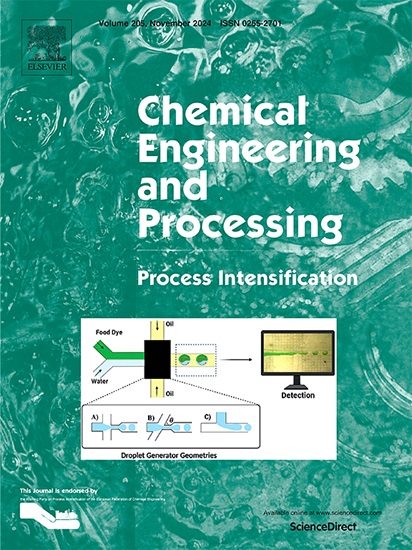Electrochemical CO2 reduction from NH4HCO3 in ammonia-based carbon capture: Comparison of external and in-situ carbon sources
IF 3.8
3区 工程技术
Q3 ENERGY & FUELS
Chemical Engineering and Processing - Process Intensification
Pub Date : 2025-05-13
DOI:10.1016/j.cep.2025.110361
引用次数: 0
Abstract
Combining ammonia-based carbon capture technology with electrocatalytic reduction powered by excess energy from power plants enables efficient use of captured carbon products while avoiding energy-intensive CO2 release and compression process. Revealing the impact of in-situ carbon sources on reaction activity and product selectivity is crucial in the direct electrocatalytic reduction of ammonium bicarbonate (NH4HCO3). This study compares the reduction performance of in-situ and external carbon source systems via potentiostatic reduction on Ag-based electrodes in Ar- or CO₂-saturated bicarbonate electrolytes. We found that high NH4HCO3 concentrations in the in-situ system enhance CO2 and intermediate adsorption on Ag-based catalysts, achieving CO production efficiencies comparable to external carbon sources, with a peak CO Faradaic efficiency of 62.2 % at −0.6 V and a current density of 9.84 mA·cm⁻2 at −0.8 V. NH4+ has a larger ionic radius, which increases local CO2 concentration and proton availability, enhancing CO yield and catalytic efficiency over K+ in in-situ carbon source systems. It also promotes hydrogen evolution reactions (HER), enabling efficient syngas production via dual-reaction synergy. We hope these findings provide theoretical support and guidance for system control strategies in the ammonia-based carbon capture coupled with electrocatalytic conversion technology.

氨基碳捕集中NH4HCO3的电化学CO2还原:外部和原位碳源的比较
将基于氨的碳捕获技术与由发电厂多余能量驱动的电催化还原相结合,可以有效利用捕获的碳产品,同时避免高能耗的二氧化碳释放和压缩过程。揭示原位碳源对反应活性和产物选择性的影响是直接电催化还原碳酸氢铵(NH4HCO3)的关键。本研究比较了原位碳源系统和外部碳源系统在ag基电极上在Ar或CO 2饱和碳酸氢盐电解质中的恒电位还原性能。我们发现原位体系中高浓度的NH4HCO3增强了ag基催化剂对CO2和中间产物的吸附,达到了与外部碳源相当的CO生产效率,在−0.6 V时CO的法拉第效率峰值为62.2%,在−0.8 V时电流密度为9.84 mA·cm⁻2。NH4+具有较大的离子半径,增加了局部CO2浓度和质子可用性,提高了原位碳源体系中CO的产率和催化效率。它还促进析氢反应(HER),通过双反应协同作用实现高效合成气生产。我们希望这些发现能为氨基碳捕集与电催化转化技术的系统控制策略提供理论支持和指导。
本文章由计算机程序翻译,如有差异,请以英文原文为准。
求助全文
约1分钟内获得全文
求助全文
来源期刊
CiteScore
7.80
自引率
9.30%
发文量
408
审稿时长
49 days
期刊介绍:
Chemical Engineering and Processing: Process Intensification is intended for practicing researchers in industry and academia, working in the field of Process Engineering and related to the subject of Process Intensification.Articles published in the Journal demonstrate how novel discoveries, developments and theories in the field of Process Engineering and in particular Process Intensification may be used for analysis and design of innovative equipment and processing methods with substantially improved sustainability, efficiency and environmental performance.

 求助内容:
求助内容: 应助结果提醒方式:
应助结果提醒方式:


